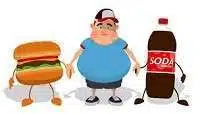
Obesity
Read the passages given below and answer the questions that follow them:
1. Obesity-linked “adult onset” diabetes mellitus is for the first time being reported in children and adolescents in the UK and many other countries. A 1986 landmark study of obesity and television viewing found a clear association between the number of hours of television a child watched and the risk of that child becoming obese or over-weight.
2. In 12 to 17-year-olds, the prevalence of obesity increases by two per cent for every hour of weekly television time. A more recent study found that, while eight per cent of children watching one hour or less of television a day were obese, 18 per cent of children watching four or more hours were obese.
3. The more children watch television, the more they eat. (By comparison, even reading is a workout, at least in studies that have been done with obese children, perhaps because it engages their minds a bit more emphatically.) Television viewing prompts children to consume more food while they consume less energy, an ideal recipe for adiposity.
4. When children dictate family food choices, as is increasingly the case in the US, entire households are immersed in a miasma of one-dimensional sweet taste that reinforces juvenile preferences. Marketing of soft, sweet and salty foods is good business, and children are the most vulnerable targets.
5. Childhood obesity rates are highest in countries where advertising on children’s television programmes is least regulated— in Australia, the US and England. Sweden and Norway maintain a virtual ban on advertising to children and have consistently low levels of childhood obesity. Ireland, Belgium, Italy and Denmark pose restrictions on children’s advertising and are pressing the other states of the European Union to do the same.
6. The US and other countries can afford to do no less. Public nutrition campaigns should go beyond vague recommendations to exercise and eat a balanced diet: the link between inactivity, junk food consumption and obesity should be made explicit. The food industry will lobby against these efforts, of course, claiming that they constitute “legislation of food choices”.
Word-Meaning: Obesity—fatness, Adolescents—who are close to attaining youth, Landmark—an important event, Obese—overweight, Prevalence—prevailing, Emphatically—forcefully, Recipe—prescription, Adiposity—fatness, Miasma—infection, decay, Juvenile—childish, Vulnerable—weak and easy to hurt physically, Targets-aims, Restrictions—limitations, Nutrition—the science of food values, Vague—not clear , Campaigns—movements, Recommendations—speaking favourably, Junk—useless or of little value, Explicit—quite clear, Lobby—trying to influence,
Attempt any eight of the following questions on the basis of the passage you have read.
1. What has been reported for the first time in the UK and other countries?
2. What has the 1986 landmark study of obesity found?
3. How does the prevalence of obesity increase with watching TV?
4. What is the relation between television viewing and food?
5. What harm has the marketing of soft and sweet food done to children?
6. Why are the obesity rates highest in Australia, the US and England?
7. What are Ireland, Belgium, Italy and Denmark trying to do?
8. What should public nutrition campaigns actually do to restrict obesity?
9. Find a word in paragraph 4 which is similar in meaning to ‘young/teenage’.
Answers
1. It has been reported for the first time in the UK and other countries that obesity and diabetes in children and adolescents have a direct relation.
2. The report has found that obesity has a direct link with television viewing.
3. Watching television for more number of hours risks becoming obese or over-weight.
4. The more children watch television, the more they eat. Consuming more food and less energy is an ideal recipe for adiposity.
5. Marketing of soft, sweet and salty foods has made children the most vulnerable targets of obesity.
6. In these countries, advertising on children television programmes is least regulated.
7. They are trying to put restrictions on children’s advertising and pressing the European Union to do so.
8. Public nutrition campaigns must go beyond vague recommendations. They must highlight the link between inactivity, junk food consumption and obesity.
9. Juvenile.
Download the above Passage Worksheet in PDF (Printable)
More Comprehension Pasages:-
Passage-61 POLLEN ALLERGY (350 Words Subjective Unsolved)
This passage is all about pollen allergy which tells pollen allergy meaning including pollen allergy remedy. You will learn pollen allergy symptoms and pollen allergy treatment. Find these pollen allergy kids.
Passage 62- Mt. Everest (326 words Subjective Solved)
Passage 63- Scents (362 words Subjective and Objective Solved)
Passage-64 INDIA – A DEVELOPING NATION (350 Words Subjective Solved)
Passage-65 Opportunities (350 Words Subjective Unsolved)
This passage is a fine opportunities definition including some opportunities examples. This clearly describes opportunities meaning and opportunities meaning in English.
Passage-66 Pressure (350 Words Objective Unsolved)
Passage- 67 Grey Wooden House (350 Words Objective Unsolved)
Passage -68 Modern Gadgets (350 Words Subjective Unsolved)
Passage -69 Denominations of 1,000 and 500 (400 Words Subjective Solved)
Passage -70 Achievemnts of Computers (350 Words Subjective Unsolved)